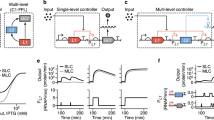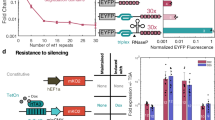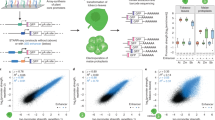Abstract
The availability of rapid and robust methods for controlling gene function is of prime importance not only for assigning functions to newly discovered genes, but also for therapeutic intervention. Traditionally, gene function has been probed by often-laborious methods that either increase the level of a gene product or decrease it. Advances now make it possible to rapidly produce zinc-finger proteins capable of recognizing virtually any 18 bp stretch of DNA—a sequence long enough to specify a unique address in any genome. The attachment of functional domains also allows the design of tailor-made transcription factors for specific genes. Recent studies demonstrate that artificial transcription factors are capable of controlling the expression of endogenous genes in their native chromosomal context with a high degree of specificity in both animals and plants. Dominant regulatory control of expression of any endogenous gene can be achieved rapidly and can be also placed under chemical control. A wide range of potential applications is now within reach.
This is a preview of subscription content, access via your institution
Access options
Subscribe to this journal
Receive 12 print issues and online access
$209.00 per year
only $17.42 per issue
Buy this article
- Purchase on SpringerLink
- Instant access to full article PDF
Prices may be subject to local taxes which are calculated during checkout



Similar content being viewed by others
References
Ptashne, M. Control of gene transcription: an outline. Nat. Med. 3, 1069–1072 (1997).
Seipel, K., Georgiev, O. & Schaffner, W. Different activation domains stimulate transcription from remote (“enhancer”) and proximal (“promoter”) positions. EMBO J. 11, 4961–4968 (1992).
Hanna-Rose, W. & Hansen, U. Active repression mechanisms of eukaryotic transcription repressors. Trends Genet. 229–234 (1996).
Tupler, R., Perini, G. & Green, M.R. Expressing the human genome. Nature 409, 832–833 (2001).
Venter, J.C. et al. The sequencing of the human genome. Science 291, 1304–1351 (2001).
Consortium, I.H.G.S. Initial sequencing and analysis of the human genome. Nature 409, 860–921 (2001).
Pavletich, N.P. & Pabo, C.O. Zinc finger–DNA recognition: crystal structure of a Zif268–DNA complex at 2.1 Å. Science 252, 809–817 (1991).
Segal, D.J. & Barbas, C.F. III., Design of novel sequence-specific DNA-binding proteins. Curr. Opin. Chem. Biol. 4, 34–39 (2000).
Elrod-Erickson, M., Rould, M.A., Nekludova, L., & Pabo, C.O. Zif268 protein–DNA complex refined at 1.6 A: a model system for understanding zinc finger–DNA interactions. Structure 4, 1171–1180 (1996).
Desjarlais, J.R. & Berg, J.M. Toward rules relating zinc finger protein sequences and DNA binding site preferences. Proc. Natl. Acad. Sci. USA 89, 7345–7349 (1992).
Nardelli, J., Gibson, T. & Charnay, P. Zinc finger–DNA recognition: analysis of base specificity by site-directed mutagenesis. Nucleic Acids Res. 20, 4137–4144 (1992).
Taylor, W.E. et al. Designing zinc–finger ADR1 mutants with altered specificity of DNA binding to T in UAS1 sequences. Biochemistry 34, 3222–3230 (1995).
Rebar, E.J. & Pabo, C.O. Zinc finger phage: affinity selection of fingers with new DNA-binding specificities. Science 263, 671–673 (1994).
Choo, Y. & Klug, A. Toward a code for the interactions of zinc fingers with DNA: selection of randomized fingers displayed on phage. Proc. Natl. Acad. Sci. USA 91, 11163–11167 (1994).
Jamieson, A.C., Kim, S.-H. & Wells, J.A. In vitro selection of zinc fingers with altered DNA-binding specificity. Biochemistry 33, 5689–5695 (1994).
Wu, H., Yang, W.-P. & Barbas, C.F. III., Building zinc fingers by selection: toward a therapeutic application. Proc. Natl. Acad. Sci. USA 92, 344–348 (1995).
Greisman, H.A. & Pabo, C.O. A general strategy for selecting high-affinity zinc finger proteins for diverse DNA target sites. Science 275, 657–661 (1997).
Segal, D.J., Dreier, B., Beerli, R.R. & Barbas, C.F. III., Toward controlling gene expression at will: selection and design of zinc finger domains recognizing each of the 5′-GNN-3′ DNA target sequences. Proc. Natl. Acad. Sci. USA 96, 2758–2763 (1999).
Dreier, B., Segal, D.J. & Barbas, C.F. III., Insights into the molecular recognition of the 3′-GNN-3′ family of DNA sequences by zinc-finger domains. J. Mol. Biol. 303, 489–502 (2000).
Dreier, B., Beerli, R.R., Segal, D.J., Flippin, J.D. & Barbas, C.F. III., Development of zinc finger domains for recognition of the 5′-ANN-3′ family of DNA sequences and their use in the construction of artificial transcription factors. J. Biol. Chem. 276, 29466–29478 (2001).
Barbas, C.F. III, & Lerner, R.A. Combinatorial immunoglobulin libraries on the surface of phage (Phabs): rapid selection of antigen-specific Fabs. Methods: Companion Methods Enzymol. 2, 119–124 (1991).
Liu, Q., Segal, D.J., Ghiara, J.B. & Barbas, C.F. III., Design of polydactyl zinc-finger proteins for unique addressing within complex genomes. Proc. Natl. Acad. Sci. USA 94, 5525–5530 (1997).
Beerli, R.R., Schopfer, U., Dreier, B. & Barbas, C.F. III., Chemically regulated zinc finger transcription factors. J. Biol. Chem. 275, 32617–32627 (2000).
Wolfe, S.A., Ramm, E.I. & Pabo, C.O. Combining structure-based design with phage display to create new Cys(2)His(2) zinc finger dimers. Structure Fold. Des. 8, 739–750 (2000).
Wang, B.S. & Pabo, C.O. Dimerization of zinc fingers mediated by peptides evolved in vitro from random sequences. Proc. Natl. Acad. Sci. USA 96, 9568–9573 (1999).
Beerli, R.R., Dreier, B., & Barbas, C.F. III., Positive and negative regulation of endogenous genes by designed transcription factors. Proc. Natl. Acad. Sci. USA 97, 1495–1500 (2000).
Kim, J.S. & Pabo, C.O. Getting a handhold on DNA: design of poly-zinc finger proteins with femtomolar dissociation constants. Proc. Natl. Acad. Sci. USA 95, 2812–2817 (1998).
Moore, M., Klug, A. & Choo, Y. Improved DNA-binding specificity from polyzinc finger peptides by using strings of two-finger units Proc. Natl. Acad. Sci. USA 98 1437–1441 (2001).
Bulyk, M., Gentalen, E., Lockhart, D.J. & Church, G.M. Quantifying DNA–protein interactions by double-stranded DNA arrays Nat. Biotechnol. 17, 573–577 (1999).
Bulyk, M.L., Huang, X., Choo, Y. & Church, G.M. Exploring the DNA-binding specificities of zinc fingers with DNA microarrays Proc. Natl. Acad. Sci. USA 98, 7158–7163 (2001).
Thiesen, H.J. & Bach, C. Target Detection Assay (TDA): a versatile procedure to determine DNA binding sites as demonstrated on SP1 protein Nucleic Acids Res. 18 3203–3209 (1990).
Moore, M., Choo, Y. & Klug, A. Design of polyzinc finger peptides with structured linkers Proc. Natl. Acad. Sci. USA 98, 1432–1436 (2001).
Kim, C.A. & Berg, J.M. A 2.2 Å resolution crystal structure of a designed zinc finger protein bound to DNA. Nat. Struct. Biol. 3, 940–945 (1996).
Isalan, M., Choo, Y. & Klug, A. Synergy between adjacent zinc fingers in sequence-specific DNA recognition. Proc. Natl. Acad. Sci. USA 94, 5617–5621 (1997).
Beerli, R.R., Segal, D.J., Dreier, B. & Barbas, C.F. III., Toward controlling gene expression at will: specific regulation of the erbB-2/HER-2 promoter by using polydactyl zinc finger proteins constructed from modular building blocks. Proc. Natl. Acad. Sci. USA 95, 14628–14633 (1998).
Isalan, M., Klug, A. & Choo, Y. Comprehensive DNA recognition through concerted interactions from adjacent zinc fingers. Biochemistry 37, 12026–12033 (1998).
Wolfe, S.A., Greisman, H.A., Ramm, E.I. & Pabo, C.O. Analysis of zinc fingers optimized via phage display: evaluating the utility of a recognition code. J. Mol. Biol. 285, 1917–1934 (1999).
Wolfe, S.A., Grant, R.A., Elrod-Erickson, M. & Pabo, C.O. Beyond the “recognition code”: structures of two Cys2His2 zinc finger/TATA box complexes Structure 9, 717–723 (2001).
Isalan, M., Klug, A. & Choo, Y. A rapid, generally applicable method to engineer zinc fingers illustrated by targeting the HIV-1 promoter Nat. Biotechnol. 19, 656–660 (2001).
Sera, T. & Schultz, P.G. In vivo selection of basic region-leucine zipper proteins with altered DNA-binding specificities. Proc. Natl. Acad. Sci. USA 93, 2920–2925 (1996).
Joung, J.K., Ramm, E.R. & Pabo, C.O. A bacterial two-hybrid selection system for studying protein–DNA and protein–protein interactions. Proc. Natl. Acad. Sci. USA 97, 7382–7387 (2000).
Cathomen, T., Stracker, T., Gilbert, L. & Weitzman, M. A genetic screen identifies a cellular regulator of adeno-associated virus. Proc. Natl. Acad. Sci. USA 93, 14991–14996 (2001).
Calvo, S. et al. Molecular dissection of DNA sequences and factors involved in slow muscle-specific transcription Mol. Cell. Biol. 21, 8490–8503 (2001).
Margolin, J.F. et al. Krüppel-associated boxes are potent transcriptional repression domains. Proc. Natl. Acad. Sci. USA 91, 4509–4513 (1994).
Heinzel, T. et al. A complex containing N-CoR, mSin3 and histone deacetylase mediates transcriptional repression. Nature 387, 43–48 (1997).
Choo, Y., Sanchez-Garcia, I. & Klug, A. In vivo repression by a site-specific DNA-binding protein designed against an oncogenic sequence. Nature 372, 642–645 (1994).
Kim, J.S. & Pabo, C.O. Transcriptional repression by zinc finger peptides. Exploring the potential for applications in gene therapy. J. Biol. Chem. 272, 29795–29800 (1997).
Kang, J.S. & Kim, J.-S. Zinc finger proteins as designer transcription factors. J. Biol. Chem. 275, 8742–8748 (2000).
Kim, J.S., Kim, J., Cepek, K.L., Sharp, P.A. & Pabo, C.O. Design of TATA box-binding protein/zinc finger fusions for targeted regulation of gene expression. Proc. Natl. Acad. Sci. USA 94, 3616–3620 (1997).
Ptashne, M. & Gann, A. Transcriptional activation by recruitment. Nature 386, 569–577 (1997).
Liu, P.-Q. et al. Regulation of an endogenous locus using a panel of designed zinc finger proteins targeted to accessible chromatin regions. J. Biol. Chem. 276, 11323–11334 (2001).
Zhang, L. et al. Synthetic zinc finger transcription factor action at an endogenous chromosomal site. J. Biol. Chem. 275, 33850–33860 (2000).
Gossen, M. & Bujard, H. Tight control of gene expression in mammalian cells by tetracycline-responsive promoters. Proc. Natl. Acad. Sci. USA 89, 5547–5551 (1992).
Wang, Y., O'Malley, B.W. Jr.,, Tsai, S. & O'Malley, B.W. A regulatory system for use in gene transfer. Proc. Natl. Acad. Sci. USA 91, 8180–8184 (1994).
No, D., Yao, T.-P. & Evans, R.M. Ecdysone-inducible gene expression in mammalian cells and transgenic mice. Proc. Natl. Acad. Sci. USA 93, 3346–3351 (1996).
Allgood, V.E. & Eastman, E.M. Chimeric receptors as gene switches. Curr. Opin. Biotechnol. 8, 474–479 (1997).
Xu, L. et al. A versatile framework for the design of ligand-dependent, transgene-specific transcription factors. Mol. Ther. 3, 262–273 (2001).
Stege, J., Guan, X., Briggs, S. & Barbas, C.F. III., p. 12 in Keystone Symposia Systems Approaches to Plant Biology (Big Sky, MT, 2001).
Eckardt, N.A. Meeting report: The new biology: genomics fosters a systems approach and collaborations between academic, government, and industry scientists. Plant Cell 13, 725–732 (2001).
Bibikova, M. et al. Stimulation of homologous recombination through targeted cleavage by a chimeric nuclease. Mol. Cell. Biol. 21, 289–297 (2000).
Author information
Authors and Affiliations
Corresponding author
Rights and permissions
About this article
Cite this article
Beerli, R., Barbas, C. Engineering polydactyl zinc-finger transcription factors. Nat Biotechnol 20, 135–141 (2002). https://doi.org/10.1038/nbt0202-135
Received:
Accepted:
Issue Date:
DOI: https://doi.org/10.1038/nbt0202-135



